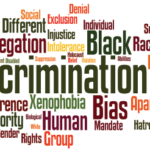 “I tell everyone who comes into her room now, ‘You will not disrespect my daughter again. No one will,’” recounts Sarah’s mother. “Every time a [provider] acts rude to her, Sarah tells me, ‘Ma, I’m used to it now,’ and I have to insist ‘No! Baby, you should never get used to that.’ … Dr. Chandler, we went to the hospital over and over again, and we never got the right help until she was almost dying. We went there, and she was not treated either time. No blood was taken, and there was no pain medication given. They said, ‘Follow up with dermatology for eczema.’ She had ulcerations down to the bone and was in a lot of pain. We sat up in that emergency department and begged to be admitted. They did nothing to address her pain. Nothing.”
“I tell everyone who comes into her room now, ‘You will not disrespect my daughter again. No one will,’” recounts Sarah’s mother. “Every time a [provider] acts rude to her, Sarah tells me, ‘Ma, I’m used to it now,’ and I have to insist ‘No! Baby, you should never get used to that.’ … Dr. Chandler, we went to the hospital over and over again, and we never got the right help until she was almost dying. We went there, and she was not treated either time. No blood was taken, and there was no pain medication given. They said, ‘Follow up with dermatology for eczema.’ She had ulcerations down to the bone and was in a lot of pain. We sat up in that emergency department and begged to be admitted. They did nothing to address her pain. Nothing.”
After nine months of symptoms, which included a 15 kg weight loss, progressive muscle weakness, arthralgias and skin lesions, 13-year-old Sarah presented to the outpatient rheumatology clinic unable to hold her neck up or stand. She had dysphasia with excessive pooling of saliva; a hoarse, barely audible voice; deep skin ulcerations; severe oral thrush; intestinal bleeding; and periorbital swelling.
Sarah was eventually diagnosed with anti-melanoma differentiation-associated gene 5 (MDA5) positive juvenile dermatomyositis (JDM), an inflammatory myopathy manifested by muscle inflammation, weakness, skin rashes and rapidly progressive, and often fatal, interstitial lung disease.1
Just six months earlier, Sarah was moving about in the fullness of her life, playing with fashion dolls and plotting mischievously with her twin brother. She and her twin are the youngest of seven children. Sarah’s mother hails from a line of clergy. Her maternal grandfather, with whom they share their dwelling space, is a pastor, as are several maternal aunts and uncles. Her paternal grandmother was a social worker and community activist in one of the city’s historically redlined neighborhoods (i.e., a discriminatory practice in which services—financial and otherwise—are withheld from potential customers who reside in neighborhoods classified as hazardous to investment).2-4 Her father has continued this legacy of service with a multi-decade-long career as an athletic director at a community center. Sarah’s parents were among the early cohorts of children in the 1970s to take part in public school busing programs.5
Racial concordance is a proxy for the degree to which patients & their unique circumstances are seen, heard & respected as fundamentally human.
This family knows racism and can readily see it in both its blatant and subtle forms. It is felt in some way every day. Racism, we know, is sometimes unconscious. It is “a belief in the inferiority of a person caused by prejudice against their ethnicity or phenotypic characteristics.”6 Racial discrimination is the “behavioral component of racism that manifests as differential treatment across various contexts such as interpersonal situations, systems and structures, and institutions.”6
Brooke A. Cunningham, MD, PhD, a general internist, sociologist and assistant professor in the Department of Family Medicine and Community Health, University of Minnesota, Minneapolis, writes, “Black and Brown mothers have concerns that white mothers do not. We stand watch over our children as this world tries to deny their beauty, thwart their genius, dim their light and too quickly take their innocence. We know the day will soon come when we will have to dry their tears and remind them that they are everything. We hold them tight, because we know there will be other days when we will not be there to comfort them.”7
Sarah’s mother continues, “We were just having this conversation a few months before all of this happened with Sarah. Saying to each other, you wouldn’t believe how many Black people are not taken seriously while at the [doctors’ office]. Another daughter was just about to have a baby and, knowing they don’t take Black women seriously, she had fears about her risk of dying in childbirth. This is truth-telling.”8
Repetitive experiences of perceived or blatant discrimination in daily life—and especially during healthcare encounters—can condition one to distrust the healthcare system and the people within it. Presenting for care can, paradoxically, pose a threat to life and dignity. The healthcare setting is, thus, inherently provocative for Sarah’s family and others who are keenly aware of racism and racial health disparities in the U.S.
Disparities
Disparity is a term used to address avoidable differences.9 Unequal health outcomes are not inherently unjust because they can arise from biology or chance.10 Disparities are “linked to social, economic, or environmental disadvantages and are fueled by bias or discrimination at the individual, institutional, and health care system levels.”11 They are “differences between groups who have systematically experienced greater obstacles to health based upon gender, age, race, ethnicity, religion, mental or physical ability, and geographic location compared to the majority population.”11
Notable racial, ethnic, socioeconomic and geographic disparities exist in care delivery, comorbidities and adverse outcomes among individuals with rheumatic diseases.12-14
“I used to love the medical field,” Sarah’s mother continues. “I’ve been working in it since I was 16, but I don’t trust them even for myself. After what I saw and experienced for months with Sarah, I don’t know if I can get [that trust] back. Every time I walk through those doors now, sadness, anger and fear come down like a flood all over me. If I could go somewhere else, I would go.”
Deterrents to Seeking Healthcare
Experiences of racism and poor communication are deterrents to seeking healthcare, even when available.15,16 What Sarah’s mother displays is the stress response from racialized trauma incurred at the individual and structural levels.17,18 Racial trauma refers to “stress responses and reactions to racialized incidents including the perceived or real threat of harm and injury, humiliating and shaming events, and witnessing racial discrimination towards oneself or other minoritized people.”19
Sarah’s mother has identified those of us she can trust. We are those from whom she feels the verbal and non-verbal communications authentically convey honor, respect and validation of her lived experience and shared humanity. We are those from whom she does not perceive the imminent threat of humiliation, shame or discrimination.
Despite the emotional trauma incurred and her misgivings about the healthcare institution, Sarah’s mother brings her daughter back biweekly for care, and Sarah’s condition has dramatically improved. She is walking without assistance and attending to most of her activities of daily living.
Repetitive experiences of perceived or blatant discrimination in daily life—& especially during healthcare encounters—can condition one to distrust the healthcare system & the people within it.
After an induction course of intravenous cyclophosphamide (Note: mycophenolate mofetil could not be readily absorbed), Sarah is on a complex, but effective, maintenance regimen of multiple immunomodulating medications that include intravenous immunoglobulin infusions, hydroxychloroquine and tofacitinib.
“What stands between a disrespected African American and the source of disrespect is almost 400 years of history, four centuries of being the target of humiliation and abuse,” writes Joy DeGruy, a sociologist and author of the book Post Traumatic Slave Syndrome: America’s Legacy of Enduring Injury and Healing. “A history of racial conflict, inequality and contempt culminates in a moment that few people not of this culture could comprehend, let alone predict. Yet every [Black American with multigenerational roots in this country] who has witnessed or heard of incidents like this understands the unspoken and ubiquitous cultural law that was operating.”20
Relationship Dynamics
I am Sarah’s primary rheumatology provider, and I share racial and cultural concordance with her family. However, not all providers on the “trusted” list do. One need not be Black to know the ubiquitous cultural law mentioned above. Greater emphasis on the quality of patient-provider communication and relationships may be an effective way to remove barriers to healthcare access.
Providers can consciously behave in ways that improve relationship dynamics when faced with justified apprehension, by using the knowledge that honor, respect and authenticity are paramount. It is also important to be mindful of the verbal and non-verbal language cues that convey when one isn’t regarded as inherently equal in human value to all others.
Paradigm Shift
We in America have been summoned to account for centuries of relational harm to minoritized peoples. Members of the rheumatology professional community are not excused from this national reckoning and must actively participate.21 We can no longer ignore or give passive attention to the striking lack of diversity in the rheumatology workforce or the under-representation of racial and ethnic minorities in clinical trials and disease registries, despite the increased prevalence of diseases like lupus in this population.22
Black physicians comprise approximately 4% of the total physician workforce, 1.3% of pediatric rheumatology providers and 0.8% of adult providers.23,24 These numbers provide indisputable evidence that the field of rheumatology’s relationship with minoritized peoples is severely flawed.
Although provider-patient concordance has been shown to improve patient satisfaction and quality of care, I believe that racial concordance is a proxy for the degree to which patients and their unique circumstances are seen, heard and respected as fundamentally human.25 We all are human; therefore, each person of sound mind has the capacity empathize, to evaluate prejudiced thought patterns and then act with empathy to remove the barriers of racism for the sake of delivering more excellent care.
Advocates focus intensively on sweeping policy change at organizational and government levels to address inequities in the healthcare system. Policy reform is an essential component for promoting health equity; however, since the inception of the American democracy, grand policy changes have not addressed the root cause of weak relationships between racially or ethnically discordant parties.
The solution for eradicating racism—and other -isms that drive many systemic inequities—are not fixed by policy changes.The resolution of America’s most challenging issue demands a paradigm shift that requires everyone to advance in inner work.
Racism is an issue of morality. If we strive to believe in the inherent nobility and the equal human value of all persons, regardless of race, gender, class, economic, educational, intellectual or ability status, then our inner thoughts will transform our outer behavior—priorities, professional processes and policies—collectively into what will be reflective of the ideals of equity and justice in all facets of rheumatology.
 Mia Taylor Chandler, MD, MPH, is a clinical rheumatology fellow at Boston Children’s Hospital.
Mia Taylor Chandler, MD, MPH, is a clinical rheumatology fellow at Boston Children’s Hospital.
Acknowledgments: Thanks to Candace Feldman, MD, ScD (Brigham and Women’s Hospital, Boston), and Mary Beth Son, MD, MSc (Boston Children’s Hospital), for their reviews and suggested edits.
References
- Nombel A, Fabien N, Coutant F. Dermatomyositis with anti-MDA5 antibodies: Bioclinical features, pathogenesis and emerging therapies. Front Immunol. 2021 Oct 20;12:773352.
- Leydon S. How a long-ago map created racial boundaries that still define Boston. WGBH. 12 Nov 2019. https://www.wgbh.org/news/local-news/2019/11/12/how-a-long-ago-map-created-racial-boundaries-that-still-define-boston.
- Taggart HT, Smith KW. Redlining: An assessment of the evidence of disinvestment in metropolitan Boston. Urban Affairs Rev. 1981 Sep;17(1):91–107.
- Badger E. How redlining’s racist effects lasted for decades. The New York Times. 24 Aug. 2017. https://www.nytimes.com/2017/08/24/upshot/how-redlinings-racist-effects-lasted-for-decades.html.
- Smith E. Racism and the Boston schools crisis. The Black Scholar. 1975 Mar;6(6):37–41.
- Jones JM. Prejudice and racism. New York, N.Y.: McGraw-Hill. 1997.
- Cunningham BA. This, too, is what racism feels like. Health Aff (Millwood). 2020 Nov;39(11):2029–2032.
- Chinn JJ, Martin IK, Redmond N. Health equity among Black women in the United States. J Womens Health (Larchmt). 2021 Feb;30(2):212–219.
- Braveman P. What are health disparities and health equity? We need to be clear. Public Health Rep. 2014 Jan-Feb;129 Suppl 2(Suppl 2):5–8.
- Woolf SH. Progress in achieving health equity requires attention to root causes. Health Aff (Millwood). 2017 Jun;36(6):984–991.
- Institute of Medicine (US) Committee on Understanding and Eliminating Racial and Ethnic Disparities in Health Care. Smedley BD, Stith AY, Nelson AR, eds. Unequal treatment: Confronting racial and ethnic disparities in health care. Washington, D.C.: National Academies Press. 2003.
- Costenbader KH, Desai A, Alarcón GS, et al. Trends in the incidence, demographics, and outcomes of end-stage renal disease due to lupus nephritis in the US from 1995 to 2006. Arthritis Rheum. 2011 Jun;63(6):1681–1688.
- Hersh AO, Case SM, Son MB, CARRA Registry Investigators. Predictors of disability in a childhood-onset systemic lupus erythematosus cohort: Results from the CARRA Legacy Registry. Lupus. 2018 Mar;27(3):494–500.
- Yazdany J, Trupin L, Tonner C, et al. Quality of care in systemic lupus erythematosus: Application of quality measures to understand gaps in care. J Gen Intern Med. 2012 Oct;27(10):1326–1333.
- Yelin E, Yazdany J, Trupin L. Relationship between process of care and a subsequent increase in damage in systemic lupus erythematosus. Arthritis Care Res (Hoboken). 2017 Jun;69(6):927–932.
- Chae DH, Martz CD, Fuller-Rowell TE, et al. Racial discrimination, disease activity, and organ damage: The Black women’s experiences living with lupus (BeWELL) study. Am J Epidemiol. 2019 Aug 1;188(8):1434–1443.
- Kessler RC, Mickelson KD, Williams DR. The prevalence, distribution, and mental health correlates of perceived discrimination in the United States. J Health Soc Behav. 1999 Sep;40(3):208–230.
- Substance Abuse and Mental Health Services Administration. Trauma-Informed Care in Behavioral Health Services. Chapter 3, Understanding the impact of trauma. Treatment Improvement Protocol (TIP) Series 57. HHS Publication No. (SMA) 13-4801. Rockville, Md. 2014. https://store.samhsa.gov/sites/default/files/d7/priv/sma14-4816.pdf.
- Comas-Díaz L, Hall GN, Neville HA. Racial trauma: Theory, research, and healing: Introduction to the special issue. Am Psychol. 2019 Jan:74(1):1–5.
- DeGruy J. Post traumatic slave syndrome: America’s legacy of enduring injury and healing. Milwaukie, Ore.: Uptone Press. 2005.
- Horowitz JM, Parker K, Brown A, Cox K. Amid national reckoning, American divided on whether increased focus on race will lead to major policy change. Pew Research Center. 6 Oct 2020. https://www.pewresearch.org/social-trends/2020/10/06/amid-national-reckoning-americans-divided-on-whether-increased-focus-on-race-will-lead-to-major-policy-change/.
- Case SM, Kerr GS, Chandler M, et al. Recognizing racial bias and promoting diversity in the rheumatology workforce. Arthritis Rheumatol. 2022 Sep; 74(9):1459–1463.
- Salsberg E, Richwine C, Westergaard S, et al. Estimation and comparison of current and future racial/ethnic representation in the US health care workforce. JAMA Netw Open. 2021 Mar1;4:e213789.
- Association of American Medical Colleges. Diversity in the physician workforce: Facts & figures 2014. http://www.aamcdiversityfactsandfigures.org.
- Jetty A, Jabbarpour Y, Pollack J, et al. Patient-physician racial concordance associated with improved healthcare use and lower healthcare expenditures in minority populations. J Racial Ethn Health Disparities. 2022 Feb;9(1):68–81. Erratum: J Racial Ethn Health. 2022 Feb;9(1):384.



